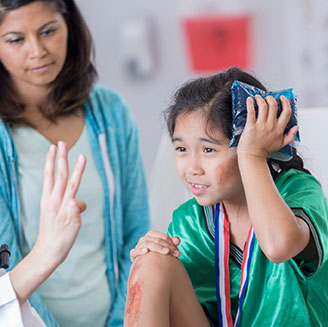4 Steps to Recovery After a Brain Injury

February 10, 2022
If you’re a sports fan, it may seem like news reports about popular professional athletes sustaining concussions and brain injuries have become increasingly common in recent years. However, it’s important to remember that brain injuries don’t just affect players in the NFL, NHL and other professional sports leagues.
“Although playing a contact sport at the professional level certainly increases the risk, there are lots of ways people can sustain a brain injury while doing normal, everyday activities,” says Christine Greiss, D.O., a physical medicine and rehabilitation specialist and director of the Concussion Program at JFK Johnson Rehabilitation Institute.
The good news is that whether a brain injury occurs during an NHL or NFL game or due to a slip, trip or fall, brain injury rehabilitation can help relieve symptoms and promote recovery.
What is brain injury rehabilitation?
Brain injury rehabilitation begins with a complete evaluation by a physician, who will assess your injury, symptoms, and physical, cognitive and mental condition. If the physician diagnoses a brain injury, they will recommend rehabilitation activities that follow a series of evidence-based steps.
How does brain injury rehabilitation work?
According to Dr. Greiss, every patient — and every brain — is different, so there is no one-size-fits-all plan for brain injury rehabilitation. But although the progression and speed of recovery may vary, rehabilitation typically follows these steps:
1. Complete physical and cognitive rest for 24-72 hours.
“After a brain injury, there is a lot going on,” says Dr. Greiss. “Forces transmitted through your brain tissue cause it to swell, and the shock slows down electrical currents, alters blood flow and changes brain chemistry.”
Dr. Greiss says that because the skull doesn’t stretch when the brain swells, physical rest is critical to reduce the risk of second-impact syndrome, a potentially disabling or fatal condition caused by repetitive head injury.
Cognitive rest involves reducing overall mental strain by:
- Avoiding screens
- Taking a break from work- or school-related tasks
- Limiting reading and thinking
2. Resume everyday activities as symptoms begin to ease.
As patients resume normal activities, they should keep an eye out for returning or worsening symptoms and adjust their activities to keep symptoms at bay.
“A patient might try reading, for example, and if symptoms return, they could take a 20-minute break to see if the symptoms subside before trying again,” says Dr. Greiss. “We want patients to do as much as their brain can handle without an increase or return of symptoms.”
Dr. Greiss also says that during this phase, she works with patients to determine what temporary accommodations they need to return to work or school, such as:
- Working from home
- Getting extra time on assignments or tests
- Dimming the lights
- Wearing sunglasses
- Limiting screen or reading time
3. Gradually returning to exercise, and consulting a physical therapist if symptoms persist.
“A patient might start off with taking a short walk outside, and if symptoms don’t reappear, they can progress to walking faster or walking for a longer period of time,” says Dr. Greiss. “Patients can then try weightlifting with light weights and gradually increasing the weight, or try jogging or sprinting as tolerated.”
If symptoms are persistent, patients may benefit from working with a physical therapist who will:
- Monitor heart rate and blood pressure during exercise
- Establish the threshold where symptoms recur
- Help patients exercise below this threshold to prevent symptom recurrence
- Gradually expand the patient’s exercise capabilities
- Assist with vestibular rehabilitation, which helps relieve balance or visual symptoms by desensitizing the brain to movement
4. Return to sports.
Athletes may return to sports only when they are able to exercise at their baseline level without symptoms returning.
“At first, athletes should begin with non-contact drills and successfully progress to contact drills before returning to competition,” says Dr. Greiss.
During all stages of recovery, Dr. Greiss advises her patients to eat a well-balanced diet that includes approximately 300 extra calories per day to support brain healing. She also recommends that patients avoid alcohol and drugs and get plenty of sleep.
“At JFK Rehabilitation Institute, we follow the latest protocols and guide patients through the brain injury recovery process so they can safely return to the activities they love,” says Dr. Greiss.
Next Steps & Resources:
- Meet our Experts: Christine Greiss, D.O.
- To make an appointment with Dr. Greiss or a doctor near you, call 800-822-8905 or visit our website.
The material provided through HealthU is intended to be used as general information only and should not replace the advice of your physician. Always consult your physician for individual care.






